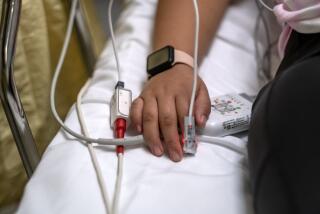Orange County
- Share via
Ventura County officials must identify a building where infected patients could be isolated and treated in the event of a smallpox outbreak.
Additionally, a cadre of doctors, nurses, police officers and firefighters should attempt to get smallpox inoculations in advance so they can safely attend to the sick.
Those are some of the findings from a mock bioterrorism emergency conducted this week in Thousand Oaks.
The four-hour exercise was held with the Ventura County Board of Supervisors in attendance to bring its members up to date on the county’s readiness for terrorist incidents in the wake of Sept. 11, said Eric Nishimoto, a spokesman for the county Sheriff’s Department.
It was organized by the Terrorism Working Group, a multi-agency task force that meets regularly to make sure the county is prepared for potential terrorist scenarios.
A smallpox outbreak was chosen because it represents a “worst-case event” that would fully test the county’s ability to respond, Nishimoto said.
That is because smallpox is a highly contagious virus that could be difficult to contain. There is a limited--and tightly controlled--supply of vaccine, which could force public health officials to make tough decisions about who gets priority for treatment.
Supervisor Frank Schillo said he came away persuaded that the county, for the most part, would react quickly if a smallpox case were found.
“Everybody knows their job and we have a solid plan,” Schillo said.
The most important immediate response would be to inform the public about the outbreak and who is at risk of infection, Schillo said.
That would be accomplished by passing verified information to the media as quickly as possible, he said. If people don’t know what is happening, they could become panicked and begin spreading rumors, he said. The exercise pointed out that the FBI would be able to share information about an infected person’s movements so that anyone who came in close contact could be notified of potential exposure, Schillo said.
The simulation also underscored that there are still some holes in the county’s plan. Chief among them are where infected people would be taken, Schillo said. Because they would be contagious, it would be unwise to move those infected into hospitals, health advisors said.
Empty buildings suitable to treat patients must be found, Schillo said. The old St. John’s Hospital in Oxnard or the former Westlake Hospital were among recommended sites. Using state armories as quarantine facilities was also suggested.
“No decisions have been made. It just depends on whether they would work and are available. But together, they would hold hundreds and hundreds of people,” Schillo said.
Community Memorial Hospital in Ventura is renting a 60-foot trailer to isolate potential smallpox patients, said hospital administrator Michael Bakst. The trailer is expected to arrive Monday and will be located next to the emergency room. It is separate from the hospital building, Bakst said.
The trailer contains four treatment areas and a reception area and is equipped with a filtration system. It would be activated immediately after a smallpox case is identified anywhere in the Western United States, Bakst said.
Select hospital staff members have also been trained in how to deal with smallpox-infected patients, he said. Hospital leaders took the precaution after Sept. 11, even though many believe a smallpox outbreak is unlikely.
“My hope is we will never have to use it,” Bakst said. “But we needed to think it through before it happens and not after.”
County authorities are also concerned with how to protect firefighters, police officers and health workers who would be called on to transport or provide medical treatment to the sick.
The Centers for Disease Control and Prevention in Atlanta has about 12 million doses of smallpox vaccine, but tightly controls how they are distributed, said Dr. Robert Levin, Ventura County’s public health officer.
If the virus is found here, the CDC has promised to send a medical team within 12 hours to begin vaccinating anyone who has been exposed.
But the federal health agency is making no promises when it comes to inoculating others, Levin said.
“We have to lobby the CDC to create a policy which makes it available to groups of first responders throughout the nation,” Levin said.
CDC guidelines released last month state that people involved in direct patient care would be considered a high priority for vaccination if outbreaks begin.
But any decision to extend the shots to law enforcement personnel, firefighters and public health officials will be at the CDC’s discretion.
Those guidelines were successfully employed 30 years ago, before smallpox was eradicated globally, and they should work just as well for any new emergencies, CDC officials said.
The last case of smallpox occurred in 1977.
But it is considered one of several bioagents that could be revived by terrorists to devastate populations.
Carried on airborne particles, the virus is spread by coughing, sneezing or contact with skin lesions. It often spreads silently because symptoms of rash, fever and muscle aches do not appear for seven to 12 days.
A vaccine is effective if given within a week of exposure. But smallpox kills up to one-third of those infected.
More to Read
Sign up for Essential California
The most important California stories and recommendations in your inbox every morning.
You may occasionally receive promotional content from the Los Angeles Times.














